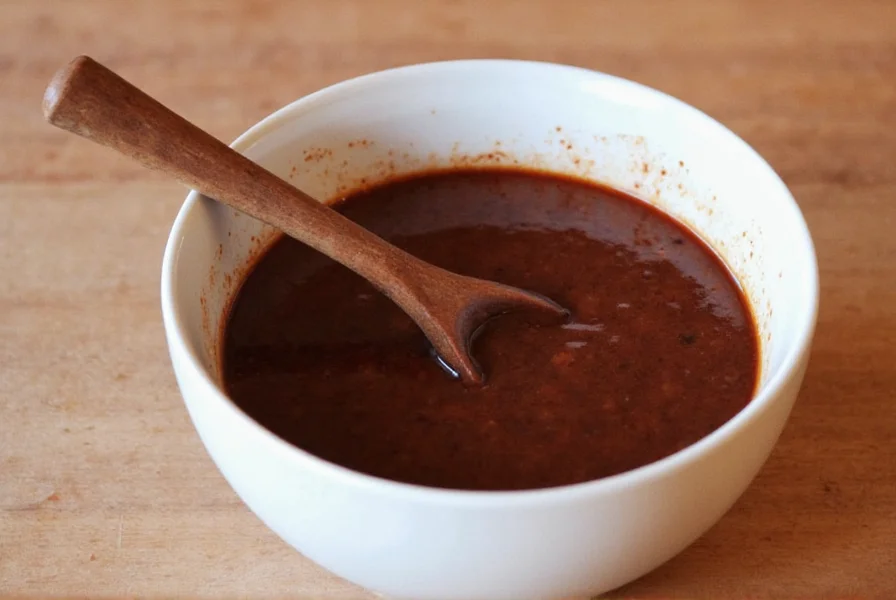If you're searching for 'what's another name for a mole,' the answer depends on context. For the iconic Mexican sauce, mole doesn't have a single alternative name in English, but specific varieties are commonly identified by color or region: Mole Negro becomes 'Black Mole,' Mole Verde is 'Green Mole,' and Mole Poblano is often called 'Classic Mole.' Understanding these naming conventions helps you navigate authentic Mexican cuisine with confidence.
Table of Contents
- What Is Mole? (And Why It Has No Direct English Equivalent)
- What's Another Name for a Mole? Clarifying the Naming Confusion
- Types of Mole and Their Regional Names
- How to Use Authentic Mole Varieties in Your Cooking
- Buying Guide: Finding the Right Mole Product by Name
- Frequently Asked Questions About Mole Nomenclature
- Final Thoughts: Understanding Mole's Naming System

What Is Mole? (And Why It Has No Direct English Equivalent)
Mole (pronounced MOH-lay) is a rich, complex Mexican sauce with deep cultural roots—not to be confused with the burrowing mammal or skin growth. The term comes from the Nahuatl word "molli," meaning sauce or mixture, which explains why there's no direct English translation for 'mole.'
Unlike many culinary terms that get translated (like 'salsa' to 'sauce'), 'mole' remains unchanged in English because it represents a unique culinary concept with no exact equivalent. When people ask 'what's another name for a mole,' they're typically referring to the various named varieties rather than seeking a complete translation.
What's Another Name for a Mole? Clarifying the Naming Confusion
When searching for 'another name for mole,' it's crucial to understand that mole itself has no single alternative term. Instead, specific types of mole are identified by descriptive names based on appearance, ingredients, or regional origin. This naming convention solves the confusion behind 'what do you call mole' in different contexts.
Here's how Mexican mole varieties are commonly referenced in both Spanish and English contexts:
| Type of Mole | Common Alternative Name / Description | Origin/Key Characteristics |
|---|---|---|
| Mole Negro | Black Mole, Oaxacan Black Mole | Oaxaca; complex blend with chocolate, multiple chiles, and burnt tortillas |
| Mole Poblano | Classic Mole, Turkey Mole | Puebla; the most internationally recognized variety often served with turkey |
| Mole Verde | Green Mole, Fresh Herb Mole | Multiple regions; features fresh herbs, pumpkin seeds, and green chiles |
| Mole Amarillo | Yellow Mole, Banana Mole | Oaxaca; lighter sauce with banana/plantain and mild chiles |
| Mole Coloradito | Reddish Mole, Little Red Mole | Oaxaca; tomato-based with a brick-red color |
This naming system answers the common question 'is mole called something else'—while the category remains 'mole,' specific varieties have descriptive alternative names that help differentiate them.

Types of Mole and Their Regional Names
Understanding 'what's another name for mole' requires recognizing that Mexico has dozens of regional mole varieties, each with distinct naming conventions. These names serve as culinary signposts that help identify ingredients and preparation methods.
Mole Poblano (The "Classic Mole")
Often mistakenly called simply "mole" outside Mexico, this Puebla specialty is technically just one variety among many. It's frequently referred to as "the traditional mole" or "mole for special occasions" in English-language contexts.
- Why this name? "Poblano" refers to people from Puebla (los poblanos)
- Common confusion: Many assume all mole is "mole poblano"
- Culinary context: Traditionally served with turkey for celebrations
Mole Negro (Oaxaca's "Black Mole")
This complex sauce from Oaxaca is sometimes called "Oaxacan black mole" to distinguish it from other dark moles. The "negro" (black) refers to its deep color from charred ingredients.
- Why this name? The extensive toasting of ingredients creates a near-black color
- Common confusion: Mistaken for being extremely spicy (it's actually mild)
- Culinary context: Served at weddings and important celebrations
Mole Verde (The "Fresh Herb Mole")
Known as "green mole" in English, this fresh-tasting sauce gets its color from ingredients like cilantro, parsley, and tomatillo rather than dark chiles.
- Why this name? "Verde" means green in Spanish
- Common confusion: Sometimes mistaken for salsa verde
- Culinary context: Common in central Mexico for everyday meals

How to Use Authentic Mole Varieties in Your Cooking
When you understand 'what another name for mole might be,' you can better follow authentic recipes and find the right product. Here's how to use specific mole varieties correctly:
- For Mole Poblano (Classic Mole): Traditionally paired with turkey, but works beautifully with chicken. Never served with beef despite common misconceptions.
- For Mole Negro (Black Mole): Requires careful balancing—too much chocolate overwhelms the complex chile flavors. Best with poultry or pork.
- For Mole Verde (Green Mole): Cook quickly to preserve fresh herb flavors. Perfect with chicken or as a base for enchiladas verdes.
- For Mole Amarillo (Yellow Mole): The sweetest variety, excellent with fish or vegetables. Often includes banana for natural sweetness.
- For Mole Coloradito (Reddish Mole): The most versatile for beginners, with a tomato-based flavor profile that works with multiple proteins.
Pro Tip: When shopping for 'mole sauce alternative names,' look for the specific variety name rather than just 'mole' to ensure you're getting the flavor profile you want.

Buying Guide: Finding the Right Mole Product by Name
Understanding 'what do you call mole' varieties helps you navigate store shelves and online listings. Here's how to identify authentic products:
1. Authentic Mole Poblano Paste – Doña María
- What to look for: "Mole Poblano" or "Mole Para Pavo" (Turkey Mole) on label
- Why it matters: Avoids confusion with other mole varieties
- Best for: Traditional holiday meals requiring the classic poblano flavor
2. Artisanal Mole Negro Mix – Casa Oaxaca
- What to look for: "Mole Negro" with Oaxacan origin specified
- Why it matters: True mole negro requires specific Oaxacan techniques
- Best for: Special occasions where authentic black mole is needed
3. Fresh Mole Verde Kit – Tierra de Sabor
- What to look for: "Mole Verde" with fresh ingredients listed
- Why it matters: Distinguishes from cooked green sauces
- Best for: spring dishes requiring vibrant, fresh flavor
4. Traditional Mole Coloradito – La Soledad
- What to look for: "Mole Coloradito" rather than generic "mole rojo"
- Why it matters: Coloradito has specific ingredient ratios different from other red moles
- Best for: everyday cooking where a milder mole flavor is preferred

Frequently Asked Questions About Mole Nomenclature
Understanding mole's naming conventions clears up common confusion. Here are answers to the most frequent questions about mole terminology:
What's another name for mole sauce in English?
Mole has no direct English translation—it's a uniquely Mexican culinary concept. Specific varieties are described by color ("Black Mole" for Mole Negro) or region ("Puebla-style Mole" for Mole Poblano), but the category itself remains "mole."
Why don't they translate 'mole' to 'sauce' in English menus?
Like 'sushi' or 'taco,' 'mole' has become the accepted term in English culinary vocabulary. Translating it to "sauce" would lose the cultural specificity and might cause confusion with other sauces like salsa or adobo.
Is 'mole poblano' the only type people refer to as just 'mole'?
Yes—outside of Mexico, "mole" often refers specifically to Mole Poblano, creating confusion. Within Mexico, "mole" is the category name, and specific varieties always include descriptors like "negro," "verde," or "poblano."
What's the proper way to refer to mole when writing a recipe?
Always specify the variety: "Mole Poblano," "Mole Negro," etc. If you simply write "mole," experienced cooks will assume you mean Mole Poblano, but this can cause confusion with authentic Mexican cooks who recognize dozens of varieties.
Why do some recipes call it 'mole sauce' if mole already means sauce?
This is redundant in Spanish ("mole" = sauce), but English speakers add "sauce" for clarity. It's similar to saying "guacamole dip"—technically redundant but helpful for English-speaking audiences unfamiliar with the term.
Final Thoughts: Understanding Mole's Naming System
So, 'what's another name for a mole?' The answer is nuanced: mole itself has no direct English equivalent, but specific varieties are consistently identified by descriptive alternative names. Understanding these naming conventions—Black Mole for Mole Negro, Green Mole for Mole Verde, and Classic Mole for Mole Poblano—gives you the knowledge to navigate authentic Mexican cuisine confidently.
When shopping or following recipes, always look for the specific variety name rather than just 'mole' to ensure you're getting the flavor profile you want. This naming precision honors the rich culinary tradition behind each unique mole variety and helps preserve the cultural significance of these beloved sauces.
Now that you understand mole's naming system, you can explore authentic recipes and products with confidence—no longer wondering 'what do you call mole' in different contexts!











 浙公网安备
33010002000092号
浙公网安备
33010002000092号 浙B2-20120091-4
浙B2-20120091-4